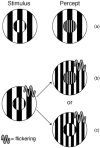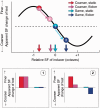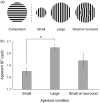Spatial Frequency Shifts From Counterphase Flicker and From Simultaneous Contrast
- PMID: 28567269
- PMCID: PMC5439650
- DOI: 10.1177/2041669517707766
Spatial Frequency Shifts From Counterphase Flicker and From Simultaneous Contrast
Abstract
In simultaneous contrast of spatial frequency (SF), a test grating surrounded by a coarser inducing grating looks apparently finer. We combined this effect with another visual illusion; the fact that flickering the inducing grating raises its apparent SF. We found that the inducer's apparent, not physical spatial frequency, drove the simultaneous contrast that it induced into a test grating. Thus, when the inducer was made to flicker, its SF appeared to be higher and consequently, the test's SF appeared lower than before. This suggests that simultaneous contrast of spatial frequency exists further downstream than the flicker-induced increase in perceived SF.
Keywords: flicker; frequency doubling; simultaneous contrast; spatial frequency.
Figures









Similar articles
-
Flicker adaptation or superimposition raises the apparent spatial frequency of coarse test gratings.Vision Res. 2015 Mar;108:85-92. doi: 10.1016/j.visres.2015.01.005. Epub 2015 Feb 7. Vision Res. 2015. PMID: 25666488
-
Spatial structure of the frequency doubling illusion.Vision Res. 2007 Jun;47(13):1732-44. doi: 10.1016/j.visres.2007.03.013. Epub 2007 May 3. Vision Res. 2007. PMID: 17481693
-
Perceived spatial frequency of flickering gratings: a local spatial distortion.Perception. 1980;9(4):403-9. doi: 10.1068/p090403. Perception. 1980. PMID: 7422458
-
Nonlinear visual responses to flickering sinusoidal gratings.J Opt Soc Am. 1981 Sep;71(9):1051-5. doi: 10.1364/josa.71.001051. J Opt Soc Am. 1981. PMID: 7277060
-
On the separability of two mechanisms involved in the detection of grating patterns in humans.J Physiol. 1979 Jun;291:251-63. doi: 10.1113/jphysiol.1979.sp012810. J Physiol. 1979. PMID: 480212 Free PMC article.
References
-
- Anstis S., Casco C. (2006) Induced movement: The flying bluebottle illusion. Journal of Vision 6: 1087–1092. Retrieved from http://journalofvision.org/6/10/8/, doi:10.1167/6.10.8. - PubMed
-
- Blakemore C., Sutton P. (1969) Size adaptation: A new aftereffect. Science 166: 245–247. - PubMed
-
- Brainard D. H. (1997) The psychophysics toolbox. Spatial Vision 10: 433–436. - PubMed
LinkOut - more resources
Full Text Sources
Other Literature Sources

